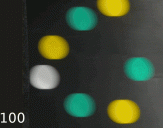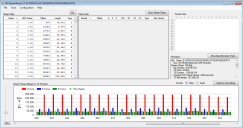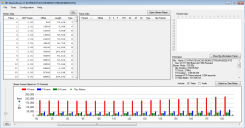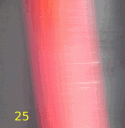
It allows to keep PV going, with more focus towards AI, but keeping be one of the few truly independent places.
-
@Roberto Thanks for your time on this. As someone who has banged around with this for weeks and weeks (and slowly going crazy)LOL!!
I tested all of the recommended new Driftwood settings this morning 24P and 29.97 too with Shutter at 30.
Anyways...its 24P where the problem is...not 50P, 29.97 or Mjpg either, Its 24P mainly and at 50 or 40 shutter, 30shutter at 24P definitely improves things, but the strobing is still there and it is not as as good as 29.97 unfortunately. To test 25P (which is the other setting that is also stroby) you will need to format your card, set one of the 3 mem locations to PAL output, sometimes you have to format the card twice to get it not to seize up...and then set to HBR.
You probably know all this anyway.
Cheers
-
@driftwood I tested all your new settings this morning.
I will wait till you reply and give you a breakdown. Cheers Mate
-
Well, the barrel happens to have a vertical pink line on the other side. It helps me count part-rotations.
Circles are used in test patterns because, even to an untrained eye, any elongation is obvious. You can tell if an image's length is, say, twice is height.
A line won't do this. It will also show jello-skew. See (in updated processed pics above, how even a circle gets skewed a little). What we want to measure in shutter is blur-length (elongation) alone.
This is a simple test with just one variable. Speed was a consistant; ie I was happy set the rotation speed to just to any one of the strobe circles in the paper disks which would harmonise with the AC lamp. These clips were shot at 42 rpm. That makes for a fast transit: 3.5 frames for the yellow circle to appear at left and disappear at right.
Sorry about the VLC's mis-reported previous fps. It was indeed 24fps -as my Linux OS desktop has since determined. I have updated the original post.
As for the colours, @Rambo , Send me your choice on the Dulux colour-chart and I'll do something to match your Hawaiian shirt ;-)
-
@Roberto then the circle is going way too fast.
If motion blur is already there in the picture to the point that we cannot even discern that yellow dot as a circle at 1/50 shutter as we should, then of course there wouldn't be any strobing either.
To replicate strobing, you need an object that moves across the frame with relatively slow speed, so when shot at 24p with 1/50 shutter, it would have perfectly sharp edges. At this point, we should see strobing.
Next, while the object keeps passing the frame with the same speed, we should have shutter speed decreased to 1/30 and 1/25th consecutively, so to see how does that affect strobing and the object's representation on-screen.
Si o no?
-
I saw in a test clip I shot the other night, that while panning in an underexposed situation with large areas of mid-tones with low details that when I went frame by frame, I could see strobing as slight changes in color. It wasn't random but I couldn't tell what kind of cadence it had. I'll see if I can replicate it and post screen grabs. I don't think what we are seeing is an actual stutter, I think it might be a change in how a frame or multiple frames look which causes jarring and draws attention to itself. I see it in all patches and stock firmware.
-
I am not convinced by playback in media players until final render out from an NLE. A lot of problems are also misinterpreted by people viewing their recordings straight from the sdcard and into a player like VLC/WMP/ etc... only to discover later that there were no artefacts or problems in the NLE. Export or view from the NLE - then let the pixel peeking begin.
Indeed in my own experience Windows users should google, download and install the K-Lite Codec Pack to give the best representation of AVCHD files when copied over to the PC.
-
Thanks for taking the time to check each frame.
While I will keep checking for motion blur at different pan speeds, I have also noticed what you see. I've started to think we need to look into the way devices handle compression/decompression as another culprit.
A passing tree may only stutter a little, but a whole forest may push the codec -either at compression stage in-camera, or de-compression using different media and different machines.
misinterpreted by people viewing their recordings straight from the sdcard
Exactly.
I've just realized I've now got to repeat my motion-blur test with multiple yellow dots, just to test the remote possibility that motion-blur itself is somehow compromised by more moving information to be compressed. (more work..Parkinson's Law, dammit)
[Edit] No problem with these multiple dots, (see animated GIF)
Another thing about checking each frame is how often a marginally-working high bitrate setting will produce just enough artefacts in occasional frames to really stuff up any hope of smooth playback anyway.
I'll personally be looking around for some quality-control application which can check the integrity of each frame in a clip automatically before they make it all the way to final edit> [another occasion where you'd want to avoid players with error-correction].

 animMultidot.GIF600 x 472 - 566K
animMultidot.GIF600 x 472 - 566K -
Hi...Hope you got my reply message? I wasn't sure as I posted it and could not find my reply again to check if you had seen it.
OK Just to clear things up. In my tests
I never test off an SD card, I have Sata 3 drives on my computer (I need fast drives for my other work).
Strobing is on VLC, WMP and the Media Player Classic-Home Cinema (all 3 of them)
Strobing is also apparent on 1080P renders from Vegas and Premiere CS6, with quality render settings.
I have the latest 64bit K-Lite pak installed, version 6.3.0.
After countless tests and literally hours of footage with different lenses, this is the conclusion I have come to.
Strobing is very noticeable on all 24P footage, especially in higher contrast areas. Lower shutter speeds (30shtr) improve it a little, but its still quite noticeable when panning the camera. (even slowly).
All 29.97...all footage is 80 to 90% better regardless of the hack related settings. But unfortunately picture the quality drops, except I thought Driftwoods Cluster G was pretty incredible at 30P which defies logic as it has an average bitrate of 38mbps and is 12 Gop...AMAZING!!
Driftwoods Crossfire setting for 24P is also incredible, but strobing is there on panning the camera, however the image quality is out of this world!! So that setting would be awesome if the camera is not moved too much.
I think that just about covers it.
Cheers
-
During my weekend of tests on 720p modes please remember if you enter a non matched shutter speed against a fps setting (e.g. 1/50 shutter on a 720p60 recording) you are more than likely to suffer problems and perhaps this could be a cause of enhanced strobing. This imbalance also creates smaller bitrate file sizes.
Ensure your shutter speed matches the frame rate (check) and in divisibles of it.
Here's a quick check using the same subject matter with 720p60 at 60 shutter (pic1) and then 50 shutter (pic2). Notice the odd B frames - all recording on the same test setting.
This may be a red herring but I'm further testing a number of users settings & other modes such as HBR.
Another test I will be looking into is timing. Perhaps we need to address the time_scale and ensure 24p/25p and 50i is set to 50000 and not 48000, and 30p and 60i is met with 60000 or divisibles of above. Again it could lead to nowhere. As soon as I get a spare moment from an edit Im working on I will conduct even deeper tests.

 720p60 at 60 shutter - perfect balance of b frames.png1293 x 680 - 70K
720p60 at 60 shutter - perfect balance of b frames.png1293 x 680 - 70K
 720p60 at 50 shutter - cadence - odd balance of B frames.png1290 x 674 - 62K
720p60 at 50 shutter - cadence - odd balance of B frames.png1290 x 674 - 62K -
@driftwood maybe thats the problem, as there is no multiple of 24 (no 48 shutter!).
-
- Thanks for testing this aspect of shutter speeds.[Can we call it synchronisation?] As I imagine it, an electronic shutter 1/25th<s/up> of an arbitrary 50 frames per second would open for 1/25th of a second. The rest of the frame would be 1/25th of a second of darkness, before the next frame would repeat the process.
- I was willing to bet that my own motion-blur tests would show insufficient blur at certain shutter settings - even with fast-moving backgrounds. Well I've tested backgrounds and found this isn't the case.
- I still have to set up some repeatable shutter-blur tests using slow-moving backgrounds (which @Astro and @Mo7ies cite as their most likely stutter-producing scenario).
- Finally, somebody needs to look right into @nomad 's idea of attack/decay of how these electronic shutters actually work. -
-
This diagram assumes that for each frame, the shutter is opened only once and for the same interval of time.

But what if the shutter kept its own time, independently of the frame speed? [I have read @Vitaliy 's explanation of how frames work and have no idea if such a thing could really happen..]
Imagine a setting up an automated cinema with a 1-hour projection time for a film which only takes up 50-minutes of each showing.
- When the cinema opens at 12:00 and the film starts at 12:10, everything ends at 13:00, everybody is happy.
- If you program the film to start out of sync, you might find you get into your seat for the 15:00 showing, only to find you're watching the credits at the end of the movie. You wait in the darkness until 15:55, when you see the Paramount lady as the film starts again.
If a video behaved like that, then you would get a few nicely blurred frames, followed by a few under-blurred ones, i.e. stutter.
BTW, one major cause of concern in complaints about government departments is when public servants assume that what has happened is what was supposed to happen :-S
-
Yes, I know you are impatient to see results for moving vertical lines. First I had to set up something to see if blurring was happening correctly at all. That part is done.
I had already tested fast-moving vertical lines (see my jello test). The blur was correct for fast shutter-speeds. I can try it again at a lower shutter speed for you.
Next, as you say, I will set up a slow-moving background of contrasting vertical lines, to look like the moving forest which is so often seen stuttering.
-
Roberto wrote:
But what if the shutter kept its own time, independently of the shutter? [I have read @Vitaliy 's explanation of how frames work and have no idea if such a thing could really happen..]
Let's avoid purely speculative posts here. They only muddy this thread.
We already have a consensus that, in fact, GH2's stutter at 24p is unusually pronounced, and just does not look good.
Now let's post some practical solutions.
So far the solution was to use 1/25 or 1/30 shutter with 24p framerate (instead of the usual 180deg shutter which would have been 1/50). Simple solution, and it works.
If you want to theorize/experiment/opine, please open your own separate thread. If you want to post a solution for the rest of us, backed by your own practical experience, by all means post it here. No offense.
I know you are impatient to see results for moving vertical lines.
Not really, I have my own video tests done long ago.
-
Sorry, @mo7ies, it was @Astro who wanted to see the slow pans.
I am pleased to note that nobody is muddying the waters - there are several ways to examine stutter; you and I agree there's something going on with blur.
Others are looking at other phenomena. I agree also that stutter itself is such a big issue that it may well deserve different threads. It certainly needs to be examined by one possible contributing factor at a time, preferably by one person/team at a time.
Now, back to my work on motion blur:
At the other side of the barrel with the multiple dots was a 2" pink line. same speed, same camera as before. Once again I've made up an animated GIF.

 LineBlur.GIF700 x 719 - 984K
LineBlur.GIF700 x 719 - 984K -
@driftwood Thanks very much...and also thanks @Roberto for your tests. I did a lot of tests a while back using 25P...cause thats the setting I need the most in Australia (HBR) TV out PAL. But at 50 shutter that strobed too, so I dont think absolutely even shutter divisions will be the answer, although if uneven shutter is crushing bitrates at 24P, that may be causing other problems. Mo7ies is right that 1/30 shutter lessens the effect, but I have noticed that in hi contrast areas even the slower shutters cause this stuttering/strobe effect at 24P As an aside I was watching Ghost Rider Spirit of Vengeance on Blu Ray the other day, I think it was shot on a Red One Mysterium X, anyway a lot of the film looks really good. There is quite a bit of strobing tho...as their are a lot of shots where the camera moves a lot, and there is a scene at 1hour-6mins-04 seconds where they run the camera forward at medium pace over some white rocks and the strobing of the rocks is very noticeable. However it was still quite a bit less strobe than the GH2 delivers, and although annoying ...it was sort of acceptable. Personally I think we will go a long way to finding a cure for this when Panansonic has their global shutter thing perfected, obviously they are aware of these issues for them to be trying to develop a new type of shutter system. Anyways in the meantime I have found Driftwoods all Intra settings (Crossfire and Quantam 100) to help in the 24P settings along with the slower shutter rate. And of course in 29.97...the problem largely goes away.
-
@Astro so, while it is fresh in memory :) which hacks do you recommend in which situations?
Separately... would you say that GH2's strobing is strongest when the datarate is lower, and so high datarate hacks help?
And finally... I saw Ghost Rider 2 in the movie theater (don't ask... was obligated), and also noticed major strobing, but mostly in the fight scenes. Alas they released the movie as 3D but as a post effect, so I thought the excessive strobing was related to the fact that they had trouble convincingly reproducing 3D effect without actually using 2 cameras. I assume though you watched it in 2D?
-
@Mo7ies Hi Yeah I agree...I think its worse when the bit rate is lower and it definitely appears that all I frames seem to work very well on 24P. I am not 100% sure of this yet, but...so far it seems that way from my own tests.
I found Quantam 100 to be very good in 24P and I also found Crossfire to be very very good (incredible actually)... it seems to be the same approach as Quantam (Intra) but the data rate is higher...bloody nice...but hungry LOL!!
If you try it...let me know what you think...it's always good to compare notes.
On the other hand I found Cluster4 (G) to render very nice detail in 29.97...I was amazed at this cause its a pretty long GOP setting and a low bitrate too, yet its detail seems really good. I havent tested it outside tho...yet, but so far so good. The 29.97 patch that is in Crossfire (the original one) is not nearly as good as Cluster4 (G) IMHO.
I think Driftwood was going to combine the Crossfire 24P and the Cluster4 (G) in one Patch, that would be great (best of both worlds). Of course we may not wish to shoot in 29.97, but its would be nice to have an efficient and clean looking patch that is a low bitrate for 29.97 and a stellar 24p frame rate setting...all on the same patch.
Yeah...About Ghost Rider I did watch it in 2D...so I dont know what caused that strobing, I saw it in the fight scenes as well...even in the restaurant, it did look a lot like like the type of strobing/shuddering the GH2 gets, but not as pronounced and therefore a bit more bearable.
Cheers
-
When the shutter is less than the frame rate in 720 50/60 on the GH1, the frame rate drops to 25 or 30fps
@Rambo -Just to clarify, If you set your GH1 to 1/25th of a second at 50fps, then the camera will default to 25fps?
The other culprit may be not really locking-in the shutter speed (say in Manual mode) , we've also noticed GH2s resetting a shutter speed [e.g. so as to lower exposure]. This can be the reason behind some under-blurred shots.
Howdy, Stranger!
It looks like you're new here. If you want to get involved, click one of these buttons!
Categories
- Topics List23,997
- Blog5,725
- General and News1,359
- Hacks and Patches1,153
- ↳ Top Settings33
- ↳ Beginners256
- ↳ Archives402
- ↳ Hacks News and Development56
- Cameras2,367
- ↳ Panasonic995
- ↳ Canon118
- ↳ Sony156
- ↳ Nikon96
- ↳ Pentax and Samsung70
- ↳ Olympus and Fujifilm101
- ↳ Compacts and Camcorders300
- ↳ Smartphones for video97
- ↳ Pro Video Cameras191
- ↳ BlackMagic and other raw cameras116
- Skill1,960
- ↳ Business and distribution66
- ↳ Preparation, scripts and legal38
- ↳ Art149
- ↳ Import, Convert, Exporting291
- ↳ Editors191
- ↳ Effects and stunts115
- ↳ Color grading197
- ↳ Sound and Music280
- ↳ Lighting96
- ↳ Software and storage tips266
- Gear5,420
- ↳ Filters, Adapters, Matte boxes344
- ↳ Lenses1,582
- ↳ Follow focus and gears93
- ↳ Sound499
- ↳ Lighting gear314
- ↳ Camera movement230
- ↳ Gimbals and copters302
- ↳ Rigs and related stuff273
- ↳ Power solutions83
- ↳ Monitors and viewfinders340
- ↳ Tripods and fluid heads139
- ↳ Storage286
- ↳ Computers and studio gear560
- ↳ VR and 3D248
- Showcase1,859
- Marketplace2,834
- Offtopic1,320







